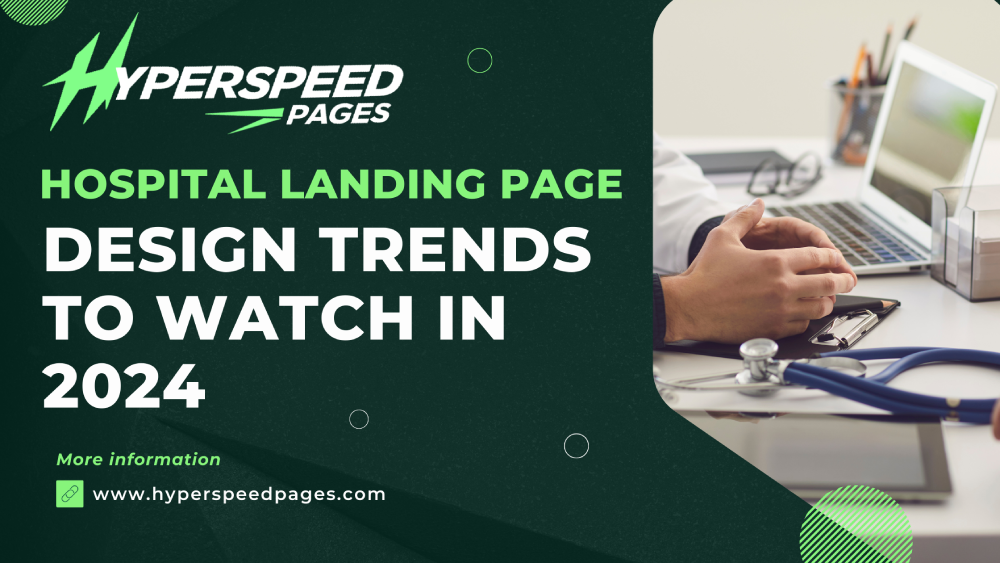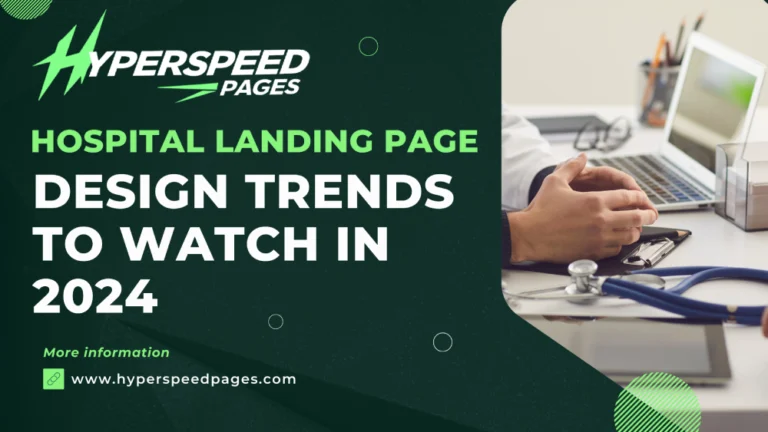
The healthcare industry has always been at the forefront of technological advancement, and this trend extends to digital marketing and online presence. Hospitals and healthcare providers are focusing more than ever on optimizing their landing pages to improve patient engagement, drive conversions, and enhance the overall user experience. The design of a hospital landing page plays a critical role in achieving these goals.
1. Personalized User Experiences Through AI and Machine Learning
Personalization has become a cornerstone of digital marketing, and in 2024, it’s making a significant impact on hospital landing pages. Leveraging AI and machine learning, hospitals can create landing pages that adapt to individual users based on their behavior, preferences, and demographics.
Key Technical Aspects
- Dynamic Content: AI-driven algorithms can tailor content in real-time. For example, a returning visitor may see different information than a first-time visitor, such as specific services they previously viewed.
- Predictive Analytics: Machine learning models analyze user data to predict what information or services a patient might need, displaying relevant content to improve the chances of conversion.
- Chatbots and Virtual Assistants: AI-powered chatbots can provide personalized assistance, answering patient queries or guiding them through the appointment booking process based on their specific needs.
2. Mobile-First Design and Accelerated Mobile Pages (AMP)
With mobile devices accounting for a significant portion of web traffic, especially in healthcare, adopting a mobile-first design approach is essential. In 2024, hospitals are prioritizing the optimization of landing pages for mobile users, focusing on speed, usability, and accessibility.
Key Technical Aspects
- Responsive Design: Ensures that landing pages adjust seamlessly to different screen sizes and orientations, providing an optimal user experience on smartphones and tablets.
- Accelerated Mobile Pages (AMP): AMP technology allows hospital landing pages to load almost instantly on mobile devices by using a stripped-down version of HTML and limiting JavaScript. This leads to faster load times and improved user engagement.
- Mobile-Optimized Forms: Simplify the process of filling out forms on mobile devices by using larger touch targets, auto-fill options, and minimal required fields.
3. Accessibility and Inclusive Design
Accessibility has always been a critical consideration in healthcare, and in 2024, it is a top priority for hospital landing pages. Ensuring that all patients, including those with disabilities, can easily access and navigate your landing page is not only a legal requirement but also a moral obligation.
Key Technical Aspects
- WCAG Compliance: Adhering to the Web Content Accessibility Guidelines (WCAG) ensures that your landing page is accessible to users with disabilities. This includes providing text alternatives for non-text content, ensuring sufficient contrast between text and background, and enabling keyboard navigation.
- Screen Reader Compatibility: Ensure that all content, including images and videos, is compatible with screen readers by using proper ARIA (Accessible Rich Internet Applications) labels and alt text.
- Voice Search Optimization: As voice search becomes more prevalent, optimizing your landing page content for voice search can help improve accessibility. This includes using natural language and answering common patient questions directly in your content.
4. Simplified Navigation and Minimalist Design
Hospitals are welcoming simplified navigation and minimalist design to reduce cognitive load and improve user experience. A clean, uncluttered layout helps patients quickly find the information they need, leading to higher conversion rates.
Key Technical Aspects
- Mega Menus: Implement mega menus that expand on hover or click, displaying a comprehensive list of services and resources without overwhelming the user.
- One-Click Navigation: Reduce the number of clicks required to reach critical information, such as appointment booking or contact details, by using clear, prominent CTAs (Call-to-Actions).
- Whitespace Utilization: Effective use of whitespace helps to guide the user’s eye to the most important elements on the page, such as CTAs, forms, or service highlights.
5. High-Quality, Engaging Visual Content
Visual content continues to be a driving factor in user engagement. In 2024, hospitals are focusing on integrating high-quality images, videos, and infographics that resonate with patients and convey trustworthiness and professionalism.
Key Technical Aspects
- Custom Photography: Stock photos are becoming less effective as users can recognize them instantly. Invest in custom photography that reflects the real environment, staff, and patient experience at your hospital.
- Video Content: Use video to explain complex procedures, showcase patient testimonials, or provide virtual tours of your facilities. Ensure that videos are optimized for fast loading and include captions for accessibility.
- Infographics: Create infographics that simplify complex medical information, making it more digestible for patients. Use vector graphics for scalability and crispness on all devices.
6. Interactive and Engaging Elements
Interactivity is a significant trend in web design, and hospital landing pages are no exception. Engaging patients through interactive elements not only makes the experience more enjoyable but also drives conversions by keeping users on the page longer.
Key Technical Aspects
- Interactive Maps: Allow patients to explore hospital facilities, locate departments, or find nearby services through interactive maps embedded directly on the landing page.
- Appointment Schedulers: Integrate interactive appointment scheduling tools that allow patients to book appointments in real-time, select their preferred doctor, and receive confirmation instantly.
- Health Calculators and Quizzes: Provide tools like BMI calculators or health risk quizzes that patients can interact with to gain insights into their health, making the landing page more engaging and informative.
- Telemedicine Integration: Virtual healthcare, including telehealth and telemedicine, has exploded since 2020. Hospitals will seamlessly integrate telemedicine services into their landing pages. Expect features like video consultations, prescription requests, and remote monitoring.
7. Data Privacy and Security Measures
With the increasing focus on data privacy, hospitals must ensure that their landing pages are secure and compliant with regulations like HIPAA (Health Insurance Portability and Accountability Act). Transparent data practices and robust security measures are essential.
Key Technical Aspects
- SSL Certificates: Ensure that your landing page uses HTTPS to encrypt all data transmitted between the user and the server. This not only protects patient data but also boosts SEO rankings.
- Data Encryption: All patient information collected through forms or interactive elements should be encrypted and stored securely, adhering to data privacy regulations.
- Privacy Policy Transparency: Clearly outline your hospital’s data collection and usage practices in a visible, easily understandable privacy policy linked directly from the newsletter landing page.
8. SEO and Content Optimization
Search engine optimization (SEO) remains a crucial factor for driving traffic to medical landing pages. Focus on creating content that not only ranks well in search engines but also provides real value to patients.
Key Technical Aspects
- Schema Markup: Implement schema markup to help search engines understand your content better and display rich snippets, such as FAQs, directly in search results.
- Content Clusters: Organize your landing page content into clusters that revolve around central topics, improving both SEO and user experience. For example, a cluster on “Cardiology Services” might include pages on specific conditions, treatments, and patient resources.
- Local SEO: Optimize your Ebook landing page for local search by including location-specific keywords, Google My Business integration, and localized content. This is particularly important for hospitals as most patients search for nearby medical services.
9. Fast Load Times and Performance Optimization
Page load time is critical in both user experience and SEO. Hospital landing pages must be optimized for speed to prevent users from bouncing and to maintain a competitive edge in search rankings.
Key Technical Aspects
- Image Optimization: Compress images without compromising quality, use next-gen formats like WebP, and implement lazy loading to ensure fast page load times.
- Caching: Utilize browser caching and content delivery networks (CDNs) to speed up the delivery of landing page content to users, especially for returning visitors.
- JavaScript Optimization: Minify and defer non-essential JavaScript to reduce the load on the browser, ensuring that essential content loads first.
10. Sustainability and Green Hosting
As sustainability becomes a global priority, hospitals are increasingly choosing green hosting solutions that minimize environmental impact. Choice of hosting provider and design practices can reflect a hospital’s commitment to sustainability.
Key Technical Aspects
- Green Hosting Providers: Choose hosting providers that use renewable energy or offset their carbon footprint. This can also be a selling point for patients who value sustainability.
- Energy-Efficient Design: Optimize landing page design to reduce energy consumption. This includes minimizing the use of heavy media files and complex animations that require more processing power.
- Sustainability Messaging: Incorporate sustainability messaging into the landing page, highlighting the hospital’s commitment to environmentally friendly practices.
Investing in the latest design and technology trends not only enhances your hospital’s online presence but also builds trust with your patients, ultimately driving better healthcare outcomes. As you plan your digital strategy for 2024, consider how these trends can be integrated into your landing pages to deliver an exceptional experience.
SOURCE:




